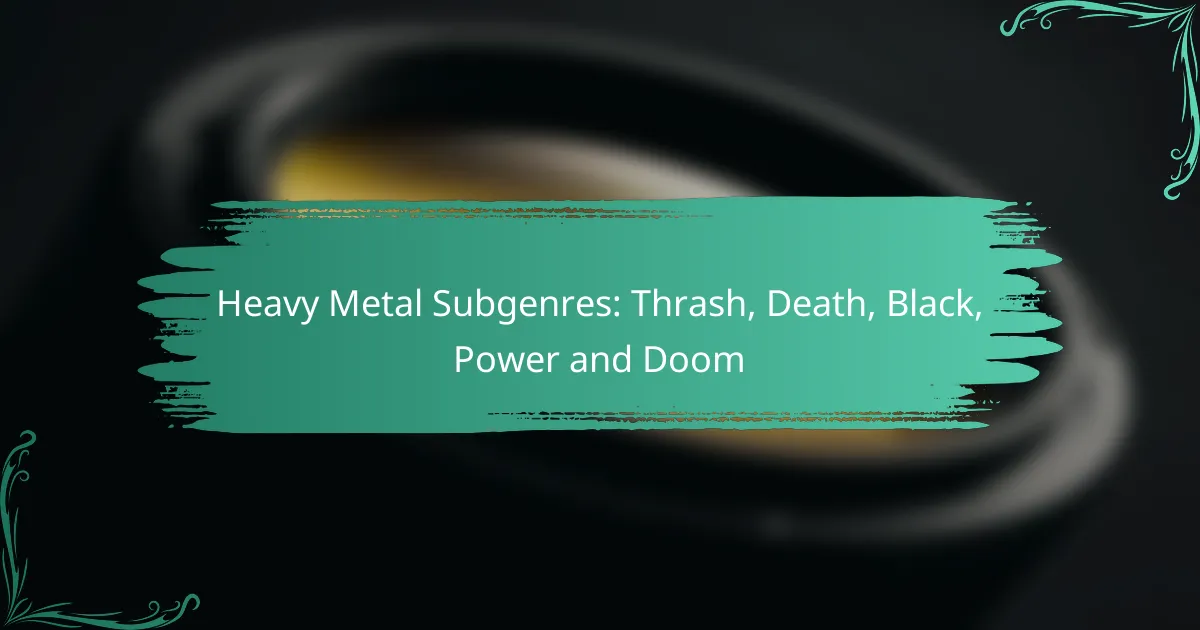Heavy metal encompasses a variety of subgenres, each with its own unique characteristics and themes. Thrash metal is known for its fast tempos and aggressive riffs, while death metal features intricate instrumentation and growled vocals. Black metal stands out with its dark atmosphere and raw production, creating a distinct sound that resonates with its themes. Additionally, power and doom metal offer contrasting experiences, with power metal focusing on melodic elements and epic themes, and doom metal emphasizing slower tempos and a heavier, more melancholic sound.
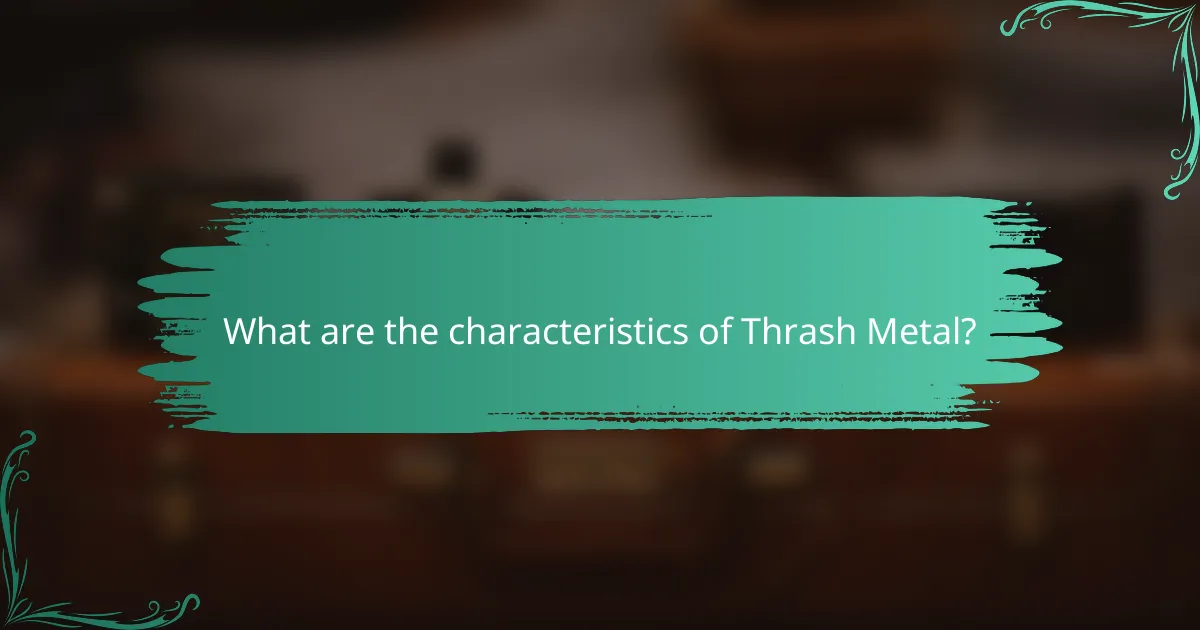
What are the characteristics of Thrash Metal?
Thrash metal is characterized by its fast tempos, aggressive guitar riffs, and a raw, energetic sound. This subgenre emerged in the early 1980s, blending elements of heavy metal and punk rock to create a distinct style that emphasizes speed and intensity.
Fast tempos and aggressive guitar riffs
Thrash metal is known for its rapid tempos, often exceeding 200 beats per minute. The guitar riffs are typically sharp and aggressive, featuring palm-muted chugging and intricate solos that showcase technical skill. This combination creates a relentless energy that drives the music forward.
Common techniques include down-picking and alternate picking, which contribute to the genre’s signature sound. Many thrash songs also incorporate tempo changes, adding complexity and keeping listeners engaged.
Influence from punk rock
Punk rock has had a significant influence on thrash metal, particularly in its attitude and approach to music. The raw, unpolished sound of early punk bands is mirrored in thrash, which often prioritizes speed and aggression over technical perfection.
This influence is evident in the lyrical themes as well, with thrash metal often addressing social issues, rebellion, and anti-establishment sentiments, similar to the messages found in punk rock music.
Notable bands: Metallica, Slayer
Metallica and Slayer are two of the most prominent bands in the thrash metal genre. Metallica, with albums like “Master of Puppets” and “Ride the Lightning,” helped bring thrash into the mainstream, combining melodic elements with their aggressive style.
Slayer, known for their darker themes and faster tempos, has made a significant impact with albums such as “Reign in Blood.” Both bands have influenced countless other artists and continue to be celebrated for their contributions to heavy metal music.

How does Death Metal differ from other subgenres?
Death metal is characterized by its aggressive sound, intricate instrumentation, and lyrical focus on darker themes. Unlike other subgenres, it emphasizes growled vocals and complex song structures, setting it apart from genres like thrash and power metal.
Growled vocals and complex song structures
One of the defining features of death metal is its use of growled vocals, which create a guttural and intense sound. This vocal style contrasts sharply with the cleaner singing found in many other metal subgenres. Additionally, death metal often incorporates complex song structures, featuring tempo changes and unconventional time signatures that challenge traditional songwriting norms.
These elements contribute to a sound that is both aggressive and technically demanding, appealing to listeners who appreciate musical complexity. Bands often experiment with various riffs and rhythms, leading to a diverse range of compositions within the genre.
Dark lyrical themes
Death metal lyrics frequently explore themes of death, violence, and existential dread, often delving into horror and the macabre. This thematic focus distinguishes it from other metal subgenres, which may address a wider array of topics, including fantasy or personal struggles. The graphic nature of the lyrics can provoke strong reactions, making them a hallmark of the genre.
While some listeners may find these themes off-putting, they are integral to the identity of death metal. The lyrics often serve as a form of storytelling, enhancing the overall atmosphere of the music and engaging fans who appreciate the genre’s darker aesthetic.
Notable bands: Cannibal Corpse, Death
Cannibal Corpse and Death are two of the most influential bands within the death metal scene. Cannibal Corpse is known for its extreme lyrical content and aggressive sound, often pushing the boundaries of what is acceptable in music. Their albums have become iconic, solidifying their status in the genre.
Death, on the other hand, is credited with pioneering the genre’s sound and complexity. Their innovative approach to songwriting and musicianship has inspired countless bands and shaped the evolution of death metal. Both bands exemplify the core characteristics of the genre, making them essential listening for anyone interested in understanding death metal’s impact on the broader metal landscape.
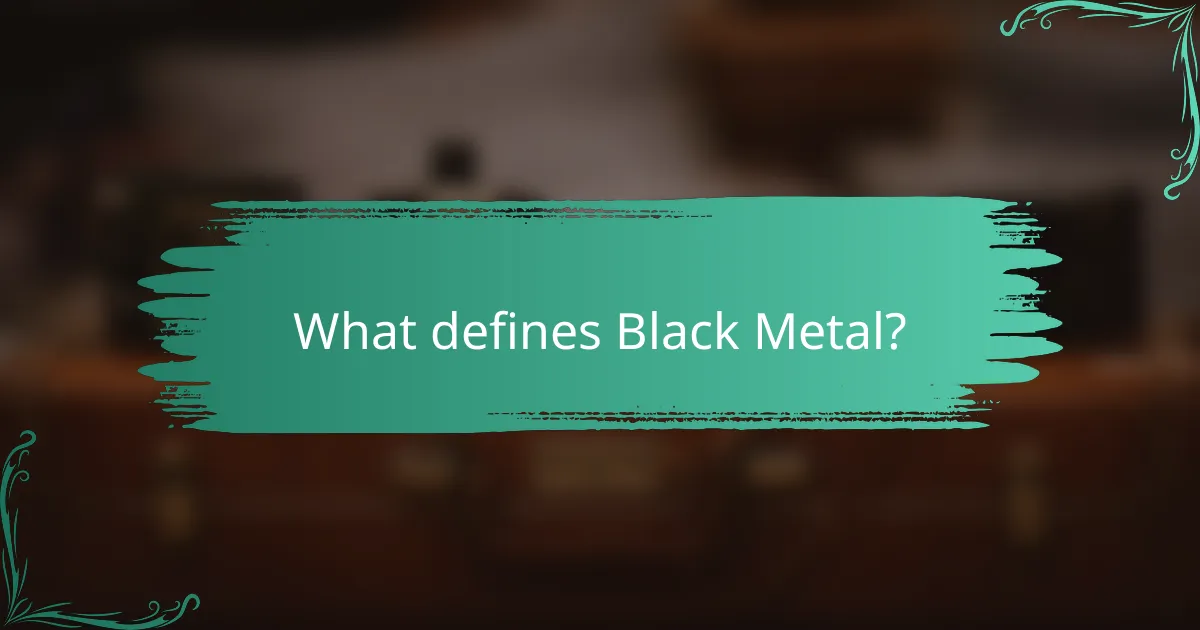
What defines Black Metal?
Black metal is characterized by its dark themes, atmospheric sound, and aggressive musical style. It often incorporates high-pitched vocals, fast tempos, and a raw production quality that sets it apart from other metal subgenres.
Atmospheric sound and high-pitched vocals
The atmospheric sound of black metal is achieved through layered guitar riffs, ambient keyboards, and a focus on creating a haunting, immersive experience. High-pitched, shrieking vocals are a hallmark of the genre, often conveying themes of despair, darkness, and nature.
This vocal style contrasts sharply with the growls found in other metal genres, emphasizing the emotional intensity of the music. The combination of atmospheric instrumentation and these distinctive vocals creates a unique auditory landscape that is both unsettling and captivating.
Use of blast beats and tremolo picking
Blast beats are a defining rhythmic element in black metal, providing a relentless, driving force that enhances the music’s intensity. This drumming technique involves rapid-fire snare hits and double bass drumming, creating a chaotic yet powerful backdrop for the guitars.
Tremolo picking, a technique where guitarists rapidly alternate between notes, is commonly used to create a sense of urgency and aggression. Together, these elements contribute to the genre’s signature sound, characterized by speed and a sense of overwhelming force.
Notable bands: Mayhem, Burzum
Mayhem and Burzum are two of the most influential bands in the black metal scene. Mayhem, known for their raw sound and controversial history, helped shape the genre’s aesthetic and musical direction in the early 1980s.
Burzum, led by Varg Vikernes, is recognized for its atmospheric compositions and philosophical themes. Both bands have left a lasting impact on black metal, inspiring countless artists and shaping the genre’s evolution over the years.
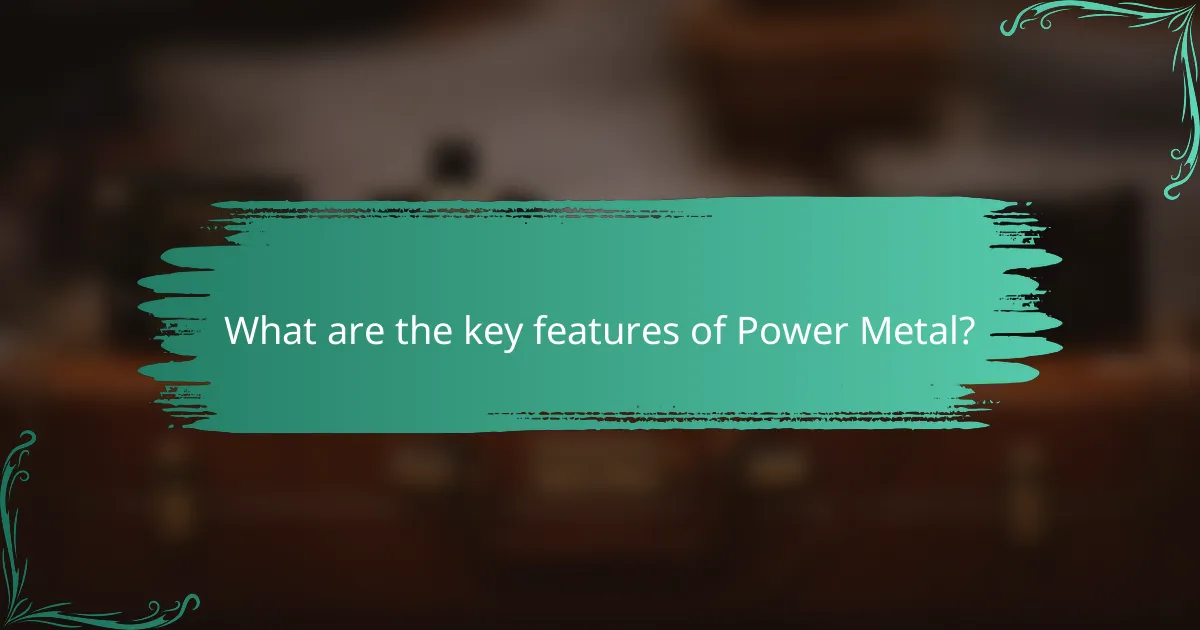
What are the key features of Power Metal?
Power metal is characterized by its fast tempos, melodic instrumentation, and uplifting themes, often drawing from fantasy and mythology. This subgenre combines elements of traditional heavy metal with symphonic and progressive influences, creating a sound that is both energetic and grandiose.
Melodic instrumentation and fantasy themes
Power metal typically features soaring guitar melodies, intricate solos, and a prominent use of keyboards, which contribute to its epic sound. The lyrics often explore themes of fantasy, heroism, and adventure, immersing listeners in imaginative worlds.
Common instruments include electric guitars, bass, drums, and synthesizers, which together create a rich, layered sound. This combination allows for dynamic shifts between powerful riffs and melodic passages, enhancing the storytelling aspect of the music.
High vocal range and epic storytelling
Vocalists in power metal often possess a high vocal range, delivering lyrics with a dramatic flair that complements the music’s grandeur. This style of singing is crucial for conveying the emotional depth of the narratives, which frequently involve quests, battles, and mythical creatures.
The storytelling in power metal is often structured like a narrative arc, with verses that build tension and choruses that deliver climactic resolutions. This approach engages listeners and invites them to become part of the epic tales being told.
Notable bands: Helloween, Blind Guardian
Helloween is often credited with pioneering the power metal genre, especially with their influential albums in the late 1980s. Their blend of speed and melody set the standard for many bands that followed.
Blind Guardian is another key player, known for their complex compositions and literary themes, often drawing inspiration from classic literature and mythology. Both bands exemplify the core elements of power metal, showcasing the genre’s signature sound and thematic depth.
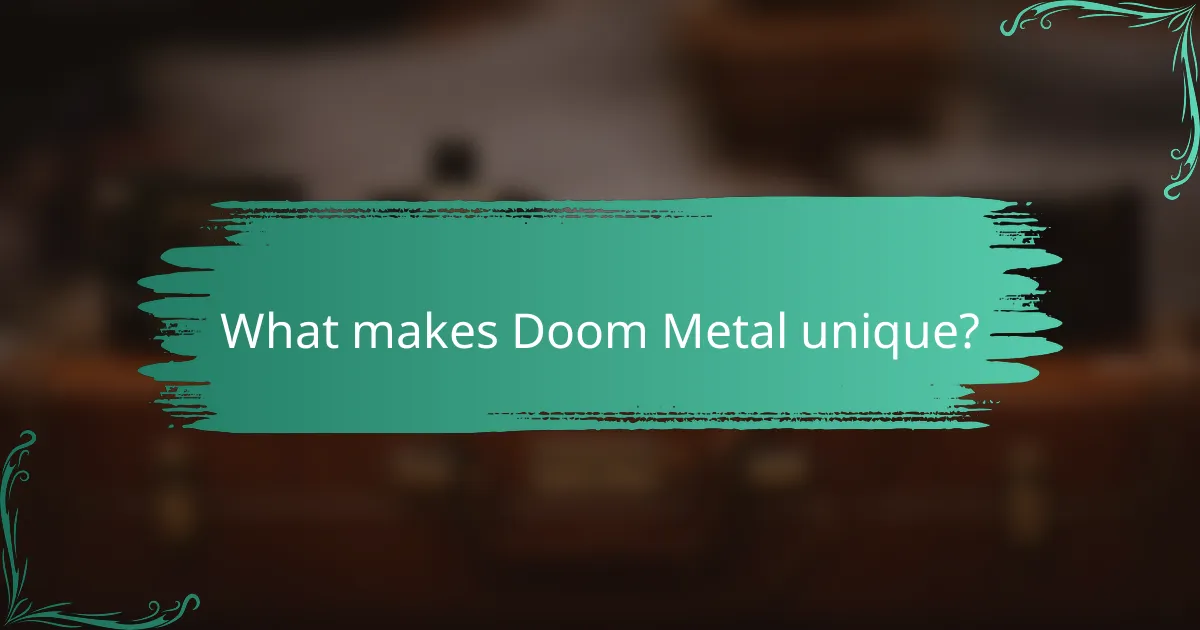
What makes Doom Metal unique?
Doom Metal is characterized by its slow tempos, heavy riffs, and a focus on creating a dark, oppressive atmosphere. This subgenre often evokes feelings of melancholy and despair, setting it apart from other metal styles.
Slow tempos and heavy, distorted guitars
Doom Metal typically features slow tempos, often ranging from 60 to 90 beats per minute, which contributes to its heavy, brooding sound. The guitar work is marked by thick, distorted riffs that create a wall of sound, often using down-tuned instruments to enhance the heaviness.
The use of power chords and extended notes allows for a sense of weight and depth, making the music feel expansive yet suffocating. This sonic approach is crucial in establishing the genre’s signature atmosphere.
Focus on atmosphere and melancholy
The atmosphere in Doom Metal is central to its identity, often incorporating themes of despair, loss, and existential dread. Lyrics frequently explore dark subjects, enhancing the emotional weight of the music.
Instrumentation, including the use of keyboards or orchestral elements, may further enrich the soundscape, creating a haunting experience. This focus on atmosphere distinguishes Doom from faster-paced metal subgenres, inviting listeners into a more introspective journey.
Notable bands: Black Sabbath, Candlemass
Black Sabbath is often credited as the pioneer of Doom Metal, with their early work laying the foundation for the genre’s sound and themes. Their heavy riffs and dark lyrics have influenced countless bands in the years since.
Candlemass is another key player in the Doom Metal scene, known for their epic compositions and powerful vocals. Their albums, particularly “Epicus Doomicus Metallicus,” are considered essential listening for anyone interested in the genre.

How can you choose the right subgenre for you?
Choosing the right heavy metal subgenre involves understanding your musical tastes and exploring different sounds. Each subgenre, such as thrash, death, black, power, and doom metal, has unique characteristics that appeal to various listeners.
Consider your musical preferences
Your personal taste in music is a crucial factor in selecting a heavy metal subgenre. If you enjoy fast tempos and aggressive riffs, thrash metal might resonate with you. Conversely, if you prefer melodic elements and epic themes, power metal could be a better fit.
Think about the elements you appreciate in music, such as lyrical content, instrumentation, and vocal styles. For example, death metal often features growled vocals and complex song structures, while doom metal is characterized by slower tempos and a heavier, darker atmosphere.
Explore playlists and compilations
Listening to curated playlists and compilations can help you discover which subgenres you enjoy the most. Many streaming platforms offer genre-specific playlists that showcase popular tracks and artists within each subgenre. This can provide a broad overview of the styles and sounds available.
Consider creating your own playlists as you explore. Include tracks that stand out to you, and pay attention to the artists and albums that consistently catch your interest. This active engagement will help you refine your preferences and guide your journey into the world of heavy metal.
